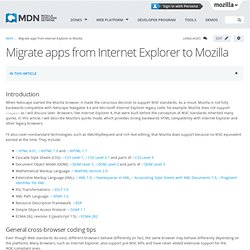

Migrate apps from Internet Explorer to Mozilla. Introduction When Netscape started the Mozilla browser, it made the conscious decision to support W3C standards.

As a result, Mozilla is not fully backwards-compatible with Netscape Navigator 4.x and Microsoft Internet Explorer legacy code; for example, Mozilla does not support <layer> as I will discuss later. Browsers, like Internet Explorer 4, that were built before the conception of W3C standards inherited many quirks. In this article, I will describe Mozilla's quirks mode, which provides strong backwards HTML compatibility with Internet Explorer and other legacy browsers.
I'll also cover nonstandard technologies, such as XMLHttpRequest and rich text editing, that Mozilla does support because no W3C equivalent existed at the time. General cross-browser coding tips Even though Web standards do exist, different browsers behave differently (in fact, the same browser may behave differently depending on the platform).
Mozilla/5.0 (X11; U; Linux i686; en-US; rv:1.5) Gecko/20031016 Tooltips ... What is minification and how do I do it? What is minification? Minification is the process of taking a file such as a stylesheet or a javascript file and removing all of the stuff that a browser doesn’t need to actually use the file. Many times the team or individual that created a stylesheet will include comments, spacing between items, extra whitespace, and various other things that make the file easier to read for a human. Introduction to Semantic HTML. Anyone who creates their own HTML pages today should aim to make their markup semantically correct.

This article explains what semantic HTML, or semantically-correct HTML, is and how it benefits web development. What is Semantic HTML? Semantics is the study of meaning: how meaning is created and applied to signs. "Why does X mean X? " is a question of semantics. HTML is the markup language that we use to write web pages. HTML consists of two types of things: TagsText content A few tags can be content of their own (like images, Flash movies, or metadata), but most HTML tags are used to apply structure to content. Semantic HTML, or "semantically-correct HTML", is HTML where the tags used to structure content are selected and applied appropriately to the meaning of the content.
Always separate style from content. How to Recruit a Frontend Hero. August 2, 2010 by Stephan Schmidt This is the first guest post on this blog.

Sebastian Deutsch (@sippndipp) was kind enough to help me with this frontend topic. Sebastian Deutsch is one of the founders of 9elements.com. 9elements is a small software boutique with a strong focus on design that loves to build web applications Recruiting a frontend developer for a large scale webapplication is a delicate task. It is that delicate because you don’t need a specialist, but you also don’t need a generalist. A second problem is that there is no industry standard for the skillset you looking for.
Q: What is the difference between strict and quirks mode? Q: Could you roughly describe the box css model? References: Q: What methods do you know to realize columns? There are several flavours in clearing, but these are the essential ones. Front-end-Developer-Interview-Questions. Front-end Job Interview Questions. A while ago, a group of very intelligent and experienced Front-end Developers got together and created a list of great Front-end focused job interview questions. This group consisted of @bentruyman,@ajpiano, @paul_irish, @SlexAxton, @boazsender, @miketaylr, @iansym, @vladikoff and @gf3. Since it’s creation, I’ve expanded to this list and happen to use it to help friends prepare for interviews (like my good friend Wes Bos / @wesbos) or to interview developers myself.
To note, I think that it’s only necessary to choose a handfull of questions from this list to get a good sense of a candidates capabilities and fit. The most telling questions often relate to what a person does in their free time. Asking about Twitter & Github Accounts, RSS feeds, Personal Blogs and general community involvement will tell you a lot about whether or not this person will stay up-to-date and is passionate about their work. Note: I’ve posted this document up on Github so that you can add to it if you want. Programadores que no programan. A raíz del artículo Programando para la Administración Pública, he recibido muchos correos y llamadas de colegas que se sentían plenamente identificados con el relato.

Incluso ha habido quienes han indentificado a algunos de los aludidos y que no han dudado en contactarme con más historias sobre esta gente ya fuera del ámbito de la Administación. Pero algo que me ha resultado francamente interesante es que, además de los comentarios de otros programadores, he tenido la oportunidad de hablar con quienes están al otro lado: consultoras y empresas.
Responsables de algunos importantes departamentos de Recursos Humanos a nivel nacional me comentaban que el panorama actual a la hora de contratar personal es desolador: casi ninguno de los candidatos que se presentan como programadores son capaces de escribir algún tipo de código. Esta afirmación no me resulta nueva. Estas pruebas son las que más me han interesado ya que permiten medir con cierta precisión el nivel real del solicitante.